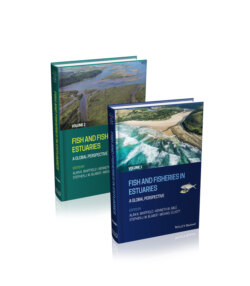Читать книгу Fish and Fisheries in Estuaries - Группа авторов - Страница 80
3.5.6 Eutrophication
ОглавлениеEutrophication via inputs of nutrients presents an increasingly common threat to reproduction of coastal and estuary‐associated fishes (FAO 1995, NRC 2000, Elliott and de Jonge 2002). While effects on fish production and yields to fisheries are not always clearly demonstrated, increasing nutrient loadings from agricultural run‐off, industrial wastewater and urban sewage (Hondorp et al. 2010) lead to eutrophication. Excessive nutrient loadings are closely tied to low dissolved oxygen levels (hypoxia) that threaten reproduction and recruitment of fishes (Holt 2002, Breitburg et al. 2018). A common consequence of eutrophication of many estuaries is the development or expansion of hypoxia (Wannamaker & Rice 2000, Buzzelli et al. 2002, Gray et al. 2002, Baird et al. 2004, Long & Seitz 2009). While hypoxia in estuaries has likely been present for millennia (Cooper & Brush 1991), the frequency, duration and spatial extent are increasing in recent decades, with interactive and sometimes complex impacts on estuarine fishes and their reproductive and recruitment potential.
In some estuaries, hypoxia adversely affects food habits of juvenile fishes (Pihl et al. 1992), growth (McNatt & Rice 2004, Stierhoff et al. 2006) and may elevate predation on fish larvae (Breitburg 1992, Breitburg et al. 1994, Shoji et al. 2005a) as well as cause direct mortality (Secor & Gunderson 1998, Shimps et al. 2005). A large portion of bottom waters in Chesapeake Bay is hypoxic (<2 mg L−1 dissolved oxygen) during summer months, rendering its deep waters inhospitable to organisms (Kemp et al. 2005) and strongly affecting abundances and depth distributions of larvae of the gobiid Gobiosoma bosc and engraulid Anchoa mitchilli, which avoided hypoxic bottom waters (Keister et al. 2000). Amongst the many experimental studies demonstrating impairment of growth and survival of young fishes under low dissolved oxygen conditions, impairment of growth is observed in estuary‐associated juvenile fishes. For example, in the pleuronectid Pseudopleuronectes americanus and the paralichthyid Paralichthys dentatus, growth rates declined by 25–50% under hypoxic conditions (Stierhoff et al. 2006).
An increasingly common consequence of excessive nutrient loadings and eutrophication in estuaries and coastal waters worldwide (Codd 1998) are harmful algal blooms (HABs). HABs are toxin‐producing micro‐phytoplankton that can kill fish, shellfish and other estuarine organisms. For example, high biomass blooms in eutrophic estuaries in South Africa cause oxygen supersaturation during bloom peaks followed by anoxia during decay, which impedes growth and nutritional condition of the larvae of the estuarine clupeid Gilchristella aestuaria, an important planktivore in these estuaries (Smit et al. 2021). Many species of dinoflagellates and cyanobacteria and some diatoms are implicated in HABs (Glibert 2016). While massive fish kills are frequently reported, effects on reproductive success and recruitment of estuarine fishes are less often documented. Persistent ‘red tides’ caused by blooms of the toxic dinoflagellate Karenia brevis in Tampa Bay (Florida) have disrupted spawning and reproductive success in the estuarine sciaenids Cynoscion arenarius, C. nebulosus and Bairdiella chrysoura (Florida Fish and Wildlife Commission 2013, Walters et al. 2013). In an example from the Baltic Sea, potentially toxic cyanobacteria (such as Nodularia spumigena, Microcystis spp. and Anabaena spp.) often cause HABs (Balode and Purina 1996). Nodularia spumigena may release its toxins during the spawning and hatching periods of the spring‐spawning and autumn‐spawning clupeid Clupea harengus (Ojaveer 1988). Microcystis aeruginosa and N. spumigena exert a harmful influence on the embryonic development and hatching of Baltic C. harengus attributable to abnormal development and high embryo mortality (Ojaveer et al. 2003).
